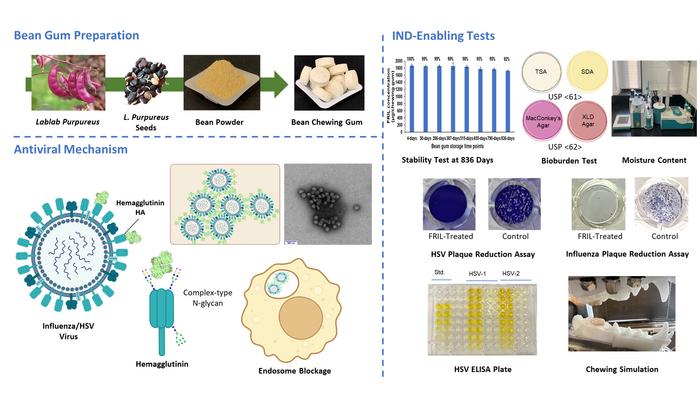In a distinct leap forward in antiviral research, scientists from the University of Pennsylvania, in collaboration with Finnish researchers, have orchestrated a remarkable study that addresses the significant challenges posed by common viral infections such as influenza and herpes simplex virus. Their innovative approach utilized a chewing gum formulation derived from lablab beans, specifically designed to neutralize viral pathogens at their transmission sites, particularly within the oral cavity. The impetus for this research was driven by the increasing prevalence of viral infections in today’s interconnected world, which has seen the rise of significant outbreaks, such as the coronavirus pandemic and other viral diseases like H1N1, SARS, and Zika.
The study’s foundation rests on an urgent need: seasonal flu epidemics lead to staggering economic burdens and health challenges, costing the United States alone over $11.2 billion annually. Additionally, the pervasive herpes simplex virus-1 (HSV-1) significantly impacts global health, affecting more than two-thirds of the world’s population and being a leading cause of infectious blindness in Western countries. Traditional methods, including vaccinations that fall short for both influenza and HSV, necessitate inventive alternatives, thus drawing the researchers’ attention to a much-overlooked method of direct viral load reduction through oral interventions.
In an influential paper published in the esteemed journal Molecular Therapy, the researchers presented their findings, building upon previous work where they demonstrated a similar strategy that effectively reduced SARS-CoV-2 viral loads in patient saliva by more than 95%. Now, in advancing their research, they have crafted a chewable gum made from a natural compound within lablab beans, known for containing the antiviral trap protein FRIL. This gum formulation has shown remarkable efficacy in neutralizing two strains of herpes simplex viruses as well as multiple strains of influenza A viruses.
The meticulous experimentation indicated that a mere 40 milligrams of this antiviral bean gum tablet, weighing only two grams, was sufficient to diminish viral loads by over 95%. This shocking reduction mirrors the outcomes witnessed in their prior studies focused on SARS-CoV-2, showcasing a consistent trend of significant viral load reduction with this formulation. Importantly, the gum has been developed to meet clinical standards, ensuring safety for usage as a potential drug product, signifying a leap towards compliance with FDA regulations.
One of the pivotal revelations from this research stems from the researchers’ emphasis on targeting the oral cavity for viral intervention. By focusing on the area of transmission, they are not merely providing symptomatic relief but are actively working towards inhibiting the virulence of these pathogens from the onset of exposure. This method represents a paradigm shift in both the understanding and treatment of viral infections, underscoring the importance of site-specific antiviral strategies.
The implications of this research extend beyond mere influenza and HSV-1. Currently, the team is strategizing to leverage this technology to confront avian influenza, particularly in light of the recent avian flu outbreaks devastating North American bird populations. The H5N1 strain of the avian flu has affected millions of birds over recent months, and with human cases being reported, this research comes at a crucial time. Utilizing lablab bean powder, known for its antiviral properties, in bird feed may provide a dual benefit—curtailing infection among bird populations while potentially safeguarding human health.
Daniell emphasizes the critical nature of this research for global health, stating that controlling virus transmission is a significant challenge, especially amidst rising infection rates and outbreaks. By harnessing the broad-spectrum antiviral capabilities of the natural protein found in lablab beans, the researchers are paving the way for innovative methods not only to manage existing viral threats but also to mitigate future risks stemming from viral infections.
As the study propels toward human clinical trials, expectations are high for its practical applications. Such an advancement could potentially revolutionize how common viral infections are managed, arguably adding a new tool to the global health arsenal. From dominating flu seasons to battling widespread herpes infections, this breakthrough stands to enhance treatment protocols in significant ways.
Henry Daniell, a pivotal figure in this research, draws attention to the pressing need for forward-thinking solutions in the realm of viral health, especially as traditional avenues of prevention falter. His ongoing collaboration with a diverse team of researchers underscores an interdisciplinary approach to tackling complex health issues. This collaboration not only reflects the necessity for collective expertise in addressing multifaceted health challenges but also emphasizes the role of innovation in public health strategy.
Lastly, the findings presented in the study reinforce the idea that natural products may offer viable solutions to human health issues. By employing widely available resources such as lablab bean powder, the researchers underscore the potential of harnessing nature’s bounty to combat viral diseases, proposing a future of antiviral therapy that is both effective and broadly accessible.
Subject of Research: Cells
Article Title: Debulking influenza and herpes simplex virus strains by a wide-spectrum anti-viral protein formulated in clinical grade chewing gum
News Publication Date: 8-Jan-2025
Web References: –
References: –
Image Credits: Credit: Yuwei Guo, Rachel Kulchar, Rahul Singh, and Geetanjali Wakade
Keywords: Influenza viruses, Avian influenza, Infectious disease transmission, Herpes simplex, Herpesviruses, Infectious diseases, Viral infections




